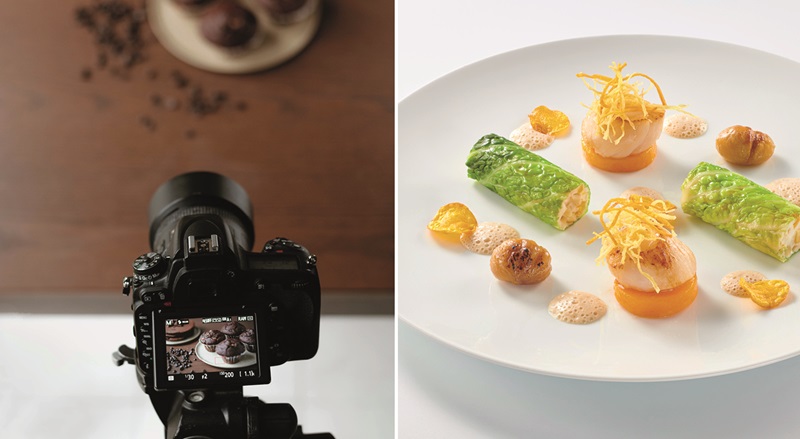-
Locations
Campuses in Europe & Middle EastCampuses in The AmericasCampuses in AsiaLe Cordon Bleu International
- Online Learning
Contact your local representative - Our Story
- Programmes
- Brochures
- News & Events
- Contact
- Find Course
 Food photography is an art that combines technique and creativity to capture the essence and beauty of dishes. More than just an image, it tells a story, evokes emotions and showcases the work of chefs.
Food photography is an art that combines technique and creativity to capture the essence and beauty of dishes. More than just an image, it tells a story, evokes emotions and showcases the work of chefs.
For renowned culinary arts institute Le Cordon Bleu Paris, understanding and mastering food photography is essential in sharing and celebrating gastronomy. Le Cordon Bleu invites you to discover the fundamentals of food photography to take your photos to a whole new level.
Food photography involves photographing food in an attractive and appetising way, to entice potential customers to eat in a restaurant, or simply to capture a moment.
It goes beyond just taking a picture of a dish; it involves capturing the textures, colours and ambience that surround the dish, making you want to eat it.
Whether it's for a cookbook, food blog or social networks, good food photography can turn a simple meal into a stunning visual experience.
There are thousands of different models of cameras and accessories (tripods, lenses, etc.).
Choosing and mastering your equipment and camera more effectively will help you understand the role of exposure, lights and lighting in general.
Food photography is like patisserie, or any other art form: The more you master your field and your tools, the more you'll be able to develop your creations with ease and creativity.
Decorative elements in food photography are important for various reasons:
By carefully selecting the materials for the backdrops (for example untreated or treated wooden boards, a tablecloth or any other polystyrene, plastic or paper surface) you can create a variety of settings and evoke different emotions.
These decorative elements can be left natural or customised with different coloured paints, leaving you with an infinite range of possibilities.
By investing in these different materials, you add depth and dynamism to your compositions, bringing out the textures and colours of the dishes.
Another important tip: Don't overload your photo! In food photography, it's more effective to adopt a minimalist approach than to overload the image with too many elements.
Often, a simple photograph focusing on a product, or a key element of a recipe, can have much stronger visual impact.
Overloading a photo can detract from the desired atmosphere and draw attention away from the essential details, making it difficult to highlight the main subject.
A final tip on overloading: Avoid using crockery that is too colourful. Too many colours in a photo will prevent you from concentrating on the central element of the photo.
To take your photo to an even higher level, there are other photography techniques as well as retouching. Find out more about these techniques below.
Editing photos, a step that is sometimes forgotten, is equally important for improving image quality. Software, such as Adobe Lightroom or Photoshop, can be used to adjust brightness, contrast, colour and detail to achieve the perfect image.
Be careful, however, to remain faithful to reality and avoid excessive retouching that could distort the dish.
Light is one of the most important elements in food photography, especially natural light, which can add a special touch to your photo.
Photographing near a window, using curtains to soften the light, helps to create bright, balanced images. Morning or late afternoon lighting is particularly recommended to obtain a warm, golden light.
If natural light is unavailable, artificial light sources can be used, such as studio lamps with diffusers.
Getting started in food photography can seem daunting, but once you have learnt the fundamentals, you can rapidly progress. The first step is understanding the importance of natural light, which brings warmth and authenticity to your images.
Try photographing near a window and experimenting with angles to avoid harsh shadows.
As far as equipment is concerned, you can start with your mobile phone or a camera if you already have one.
Try to look at the work of other photographers, analyse their portfolios and learn some photography techniques to understand what works well.With a little patience and practice, your food photography skills will quickly improve!
As you can see, food photography combines art and technique, with the aim of capturing the beauty of food and creating images that catch the eye and tantalise the taste buds.
For Le Cordon Bleu Paris culinary students and enthusiasts, understanding these key elements can not only strengthen their skills but also enable creations to be shared in a more engaging and professional way.
If you would like to begin a culinary training programme or take part in a workshop with our Chefs, Le Cordon Bleu Paris invites you to enter the magical world of gastronomy.Copyright © 2025 Le Cordon Bleu International B.V. All Rights Reserved.